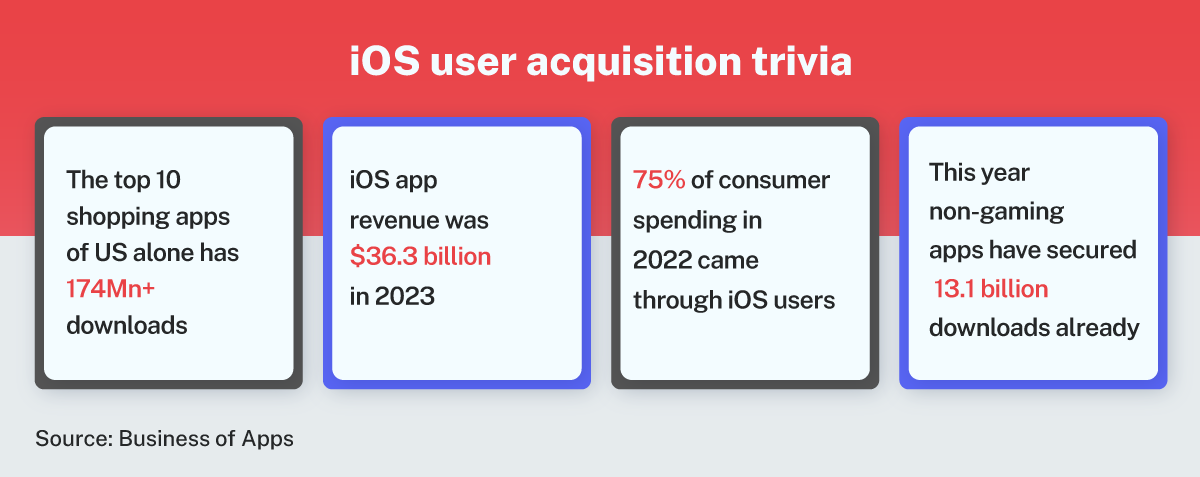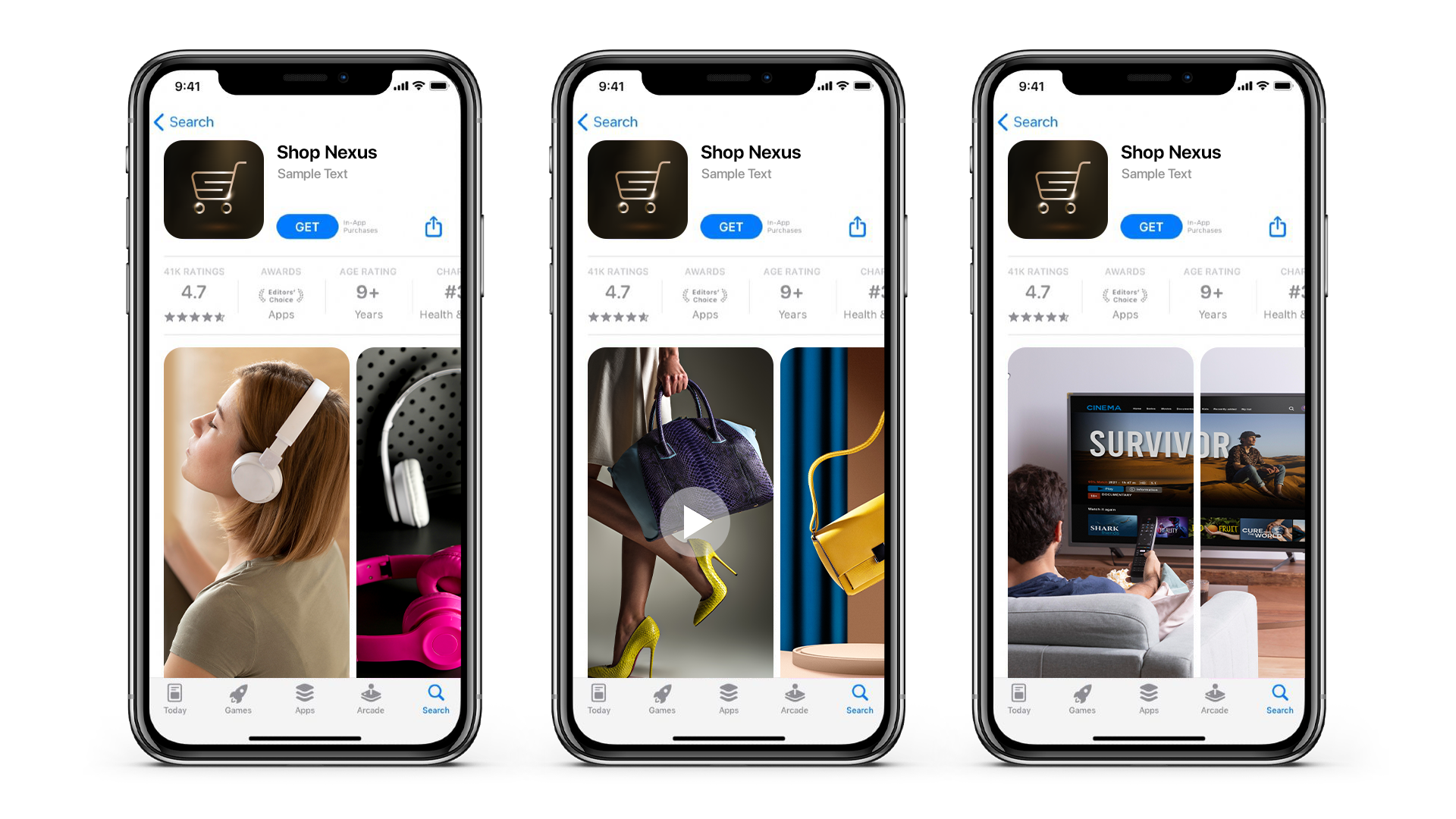
5 best practices for Apple Search Ads user acquisition in shopping category




Looking to scale up Apple Search Ads user acquisition in shopping category this festive season? We've got you covered with our top 5 best practices!
Apple Search Ads user acquisition in shopping is turning a lot of heads as we get ready to welcome the annual festival quarter. Did you know that in the US alone, the top 10 shopping apps in the App Store have recorded over 174 million downloads? Going by App Store revenues, iOS users definitely prefer to indulge in in-app purchases more as compared to Play Store users. The festive season is a good time to explore the growth opportunities that the App Store provides for shopping app user acquisition marketers. Whether you are looking to get started on Apple Search Ads user acquisition campaigns for shopping or have been using the platform for some time, this blog is for you.
Why do shopping apps prefer Apple Search Ads for user acquisition?
The ideal shopper persona is usually someone who loves to stay in touch with the latest fashion trends, is inclined to repetitive shopping, and is always on the lookout for the best deals and discounts for their favorite brands, outfits, cosmetics, or accessories. Shopping app brands in general always aim to create an online community of brand loyalists. For example, 2 beauty marketplace apps may provide the exact product range and selection of brands, yet you will often find their champion users preferring one over the other - be it for delivery timelines, offers, UI, etc.
A key indicator of a champion shopper with high LTV is how frequently they are willing to shop via your app. Today, the shopping app user acquisition marketer’s focus is on acquiring a user base that has a high propensity to purchase regularly over a period of time. That makes the App Store a lucrative ground for shopping apps looking to boost their ROAS.
Benefits and challenges of Apple Search Ads user acquisition in shopping
What makes it great?
- Access to a premium, high-intent audience
- Higher conversions on ads
- Easy to set up and launch multiple Apple Search Ads campaigns
- Funnel-based targeting options to be visible to the right audience at the right time
- Custom Product Pages offering the flexibility to appeal to different sub-segments of shoppers
What are the challenges?
- iPhones with ATT in place, respect data privacy so app marketers have to gear toward broad-level data study
- Not being able to control the exact devices that you are looking to target
- In the initial days when the campaigns are still in the learning stage, CAC can feel a little on the higher side

5 best practices to crack Apple Search Ads for shopping app user acquisition
Best practice 1: Balance is the cornerstone of keyword selection
If there’s something that most folks, aged 18-50, like to do online, then that’s shopping or watching videos. Based on the brand image and vibe that you are looking to put out there, first figure out what kind of shopper persona you most relate to - the impulsive shopper, the deal hunter, the trendsetter, the fashionista, the eco-conscious shopper, the wishlister, the accessory fans, the makeup gurus, to name a few.
Once you are clear on the sub-segments that are to be your champion shoppers, get started on identifying the search queries popular with the segments. Hardcore shoppers are usually quite aware of what exactly they are looking for. To appeal to this segment, long-tail, very specific category keywords will make for good choices. We cannot stress this enough - look at a multilingual keyword strategy to minimize lost opportunities due to language barriers alone; seek the help of genAI keyword recommendation tools if needed. Always keep an updated list of low-competition but high-value keywords to help streamline Apple Search Ads budget allocation and bid strategy.
Team suggestion: Incorporate negative keyword refining as part of your keyword research and strategy for Apple Search Ads user acquisition in shopping. In the shopping category, especially because of the multitude of shopping apps in various subsegments, a negative keyword list can help you save dollars on unnecessary ad appearances. E.g.: You are a clothing app, but you offer only Indian ethnic wear - you can put keywords like ‘western wear online’ in negative keyword lists to avoid appearing for irrelevant searches.
Best practice 2: Representation is the way to the heart of the shopping app user
Shopping is a very visual experience. You feel more convinced to buy what you can see. Ad creatives for shopping apps must be customized to represent all your diverse target personas. In the era of smartphone personalization, there’s also a higher inclination to engage more with content and brand messaging in the native languages. Therefore, look at creating more locally flavored content. Apple Search Ads helps with this nifty feature called Custom Product Pages (CPP) - they are basically a landing page for your app on the App Store. Over 35 variations of the CPP can be generated, and they are entirely localizable.

Utilize CPPs to create a diverse range of communications that appeal to your target audience and keep you ready to launch regional campaigns in a few clicks. CPPs can also be quite useful if you are a shopping app looking to focus on themes like body positivity and size inclusiveness, athleisure, makeovers, etc.
Team suggestion: Categorize your CPPs into distinct groups to ensure there’s a good extent of App Store assets that capture the essence of your brand. Build your CPPs based on region and language, audience preference, products, app USPs/competition differentiators, target personas, seasonal offers, and new launches. You can then connect the CPPs to different ad groups to launch contextual advertising campaigns on the App Store.
Best practice 3: Scale with contextual advertising and lookalike targeting for Apple Search Ads user acquisition in shopping
For a minute there, let’s go back to the first best practice. Remember how we discussed the variety of shopper segments in the App Store? Getting into deep details about your app’s shopper persona and potential personas can help you to scale your Apple Search Ads user acquisition in shopping.
There are two features that can be used here - Custom Product Pages, as we discussed above, and Search Match for Apple Search Ads user acquisition in the shopping category. Turning on Search Match in your discovery campaigns can help you identify some of the ecosystem personas you can cross-target. For example, you have a gadget marketplace shopping app that specializes in personal entertainment gadgets. The usual laptop, speaker, headphones, and TV shoppers make up your dominant target group. However, audiences looking for ‘camping gadgets’, ‘gadget ideas for musicians’, ‘office tech supplies at discount’, or ‘gaming phones’ can also make for great audience segments to explore.
Team suggestion: When running a shopping app user acquisition campaign, always try to incorporate initiatives to cross-target across fintech, qCommerce, travel, and social media categories. Brand collaborations, pushed through Special Launches and Festive Period Offers, can help to gain eyeballs from newer audience groups.
Best practice 4: Practice seasonal ad scheduling to power Apple Search Ads user acquisition in shopping user acquisition ROAS
Shopping app ROAS thrives on leveraging seasonality. Shopping has always been deeply intertwined with the overall festive experience. Brands have reported close to a 179% increase in TTRs for ads that were scheduled during peak seasonal periods like Black Friday. To run seasonal ad scheduling effectively, have a list of seasonal keywords - identify the right bid to match, pre-create a few ad groups that can be activated when the season starts, and then pause once the season is over. This will ensure you don’t miss out on important periods of peak shopping business. For example, if you are a shopping app in India, you are missing out on a large chunk of shoppers from November to April if ‘wedding shopping’ is not a campaign in focus.
Team suggestion: Globally, a few festivals always make for peak shopping periods. Simply be ready with these Apple Search Ads campaign ad groups as per your region demographics - wedding shopping, Valentine’s Day, Mother’s and Father’s Day, Halloween, Navratri and Diwali, Eid, Black Friday, Cyber Monday, Christmas, and New Year, Lunar New Year, Singles Day, Back to School, Summer Fashion. A few regular campaigns that can keep running are birthday shopping, travel shopping, and household essentials.
Also, remember to daypart your iOS shopping app user acquisition with Apple Search Ads campaigns. Shoppers usually prefer to shop in their carts during late afternoons, evenings, and over the weekends.
Best practice 5: Track it all - installs to purchases
For shopping apps, a few KPIs to track throughout the user’s journey would be ad impressions, ad clicks, downloads, signups, in-app session length, wishlists, purchases, average cart value, and frequency of shopping. However, it is not necessary to focus on all the KPIs at once. Based on your objective, you can look at focusing on one north-star KPI for each funnel stage. For example, shopping apps looking to increase quality user base only, focusing on KPIs like wishlists, add-to-cart, or in-app purchases, can direct your campaigns in the right direction. A full-funnel analysis to understand which keyword or keyword group is driving maximum ROAS is much needed to stabilize Apple Search Ads user acquisition in shopping.
Team suggestion: Integrate Apple Search Ads campaign data with MMP data to get a full view of the lead source and how it has evolved throughout the acquisition journey. At Newton, our full-funnel data integration has helped us optimize keyword lists, bid strategies, and ad group budgets for multiple shopping app campaigns.
Brand story: Apple Search Ads user acquisition in the shopping category during the festive season
Melorra, an Indian light jewelry brand, entered the App Store ecosystem as a newcomer in the space. The brand wanted to target a niche audience of working women who love to dress trendy but convenient when they are busy in their office space. The major challenge Melorra faced was the tough competition from highly established brands in the space that have been around for several decades, with a strong brand recall among the Indian audience.

Melorra took the approach of focusing on Apple Search Ads competitor campaigns. With Newton’s keyword recommendations tools, the team identified what keywords the competition was ranking and bidding on. Once they identified the high-intent competitor keywords, it was time to optimize the bidding process to continue with consistent, but sustainable campaign deliveries. The brand scaled its impressions by 1.5X, with 10% more installs delivered during the campaign duration. To know more details, read the complete case study.
Are you looking to fill up your ROAS cart this festive season? Give Apple Search Ads a try. Team Newton will be happy to help you through the overall campaign setup, execution, and optimization process.
